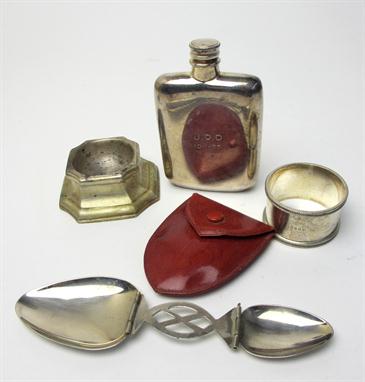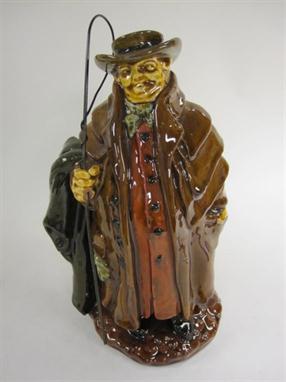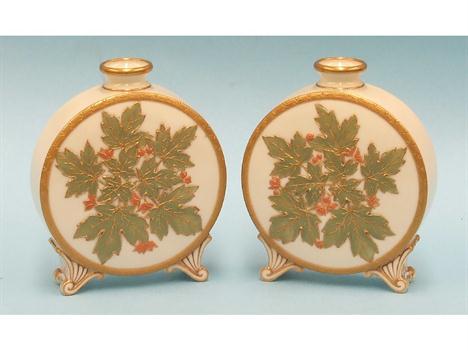We found 52452 price guide item(s) matching your search
There are 52452 lots that match your search criteria. Subscribe now to get instant access to the full price guide service.
Click here to subscribe- List
- Grid
-
52452 item(s)/page
A 5 shot 54 bore Tranter’s Patent DA percussion revolver, 11½” overall, barrel 6”, engraved on the top strap “B Cogswell, 224 Strand, London”, with London proofs, the frame and rammer engraved with scrolls, the frame also engraved “No 2074T”, the frame and rammer stamped “W Tranter’s Patent” in ovals, chequered walnut butt. GWO & C (no original finish, small patches of light pitting), in a well made modern fitted oak case with reproduction Cogswell & Harrison trade label, containing original Dixon bag shaped copper flask, original ebony handled turnscrew, and reproduction nipple key and 2 turned wood boxes for nipples etc. GC Revolver only Plate 12
GOURDE DE FORME BIANHU en bronze de très belle patine rouge jaspée de vert, reposant sur un pied tronconique, à panse ovale méplate accostée de têtes de chimères tenant des anneaux dans la gueule et petit col terminé par un bulbe. (Une petite déformation à la panse). Chine, dynastie Han (206 av. J.-C.-220 ap. J.-C.). Haut. 29 cm, H. 11 7/16 in. A bronze flask, bianhu, China, Han dynasty.
A MID 19TH CENTURY GRAINGER WORCESTER PORCELAIN PILGRIM FLASK VASE, apricot glazed and gilt, reserved with a circular panel, pâte-sur-pâte decorated with flowering branches on a sage green ground, twin scale and foliate moulded handles, oval foot, impressed mark to base rim 18cm high. See illustration
AN EDWARD VII SILVER INKWELL maker's mark rubbed, probably H Matthews, Birmingham 1908, with a cushion shape cover to the well, the sloping base with hinged flap concealing a stamp tray, 7.5cm high x 7.75cm wide x 10cm deep, together with a George V hip flask, Birmingham 1920, 9.5cm high, a small silver vase, Birmingham 1900, of flute form with a tri-lobe neck, 14cm high (3)
John Hogan (1800-1858) Bust of Francis Sylvester Mahony ("Fr. Prout") Marble, 50cm high (19.75") Made in Rome 1846 and signed Hogan Provenance, by descent in the family of the subject Literature "John Hogan, Irish Neoclassical Sculptor in Rome" (Irish Academic Press, 1982) where it is listed as No. 58 in the Catalogue Raisonné. Mahony wrote a description of Hogan's studio in Rome in the spring of 1847 which mentions his own portrait bust. "The locale which forms this sculptor's workshop (once tenanted by Canova) presents just now what may be termed a sort of Hibernian Valhalla…the bust of Father Mathew looks forth redolent of Christian philanthropy: on the same shelf is seen the mirthful brow of Father Prout…the late venerable Mr Beamish of Cork as well as his meritorious partner William Crawford, both models to any mercantile community, have their representations here, with several Murphies from that city." The bust was made before May 1847 so it is unlikely to have been this bust for which Mahony sat for Hogan in November 1847 as Turpin writes. The date is therefore likely to be 1846 rather than 1848. Turpin notes the low relief carvings on either side of the base. On one side an open chest with rolls of parchment and an antique lamp - an illusion to the 'discovery' of Fr Prout's literary remains in a chest - and on the other a book, a wine bottle, a chalice and a classical flask - apt symbols of Mahony's life. Francis Sylvester Mahony (Fr Proust) (1804-1866) "A very singular person, of whom the world tells a thousand and one tales, you know, but of whom I shall speak as I find him, because the utmost kindness and warmheartedness have characterised his whole bearing towards us….a most accomplished scholar and vibrating all over with learned associations and vivid combinations of fancy and experience - having seen all the ends of the earth and the men thereof, and possessing the art of talk and quotation to an amusing degree." Elizabeth Barrett Browning, 10th October 1848 Francis Mahony was born in Cork on 31st December 1804, the son of Martin Mahony a woollen merchant. He went to Clongowes in 1815, to the Jesuit college of St. Acheul at Amiens in 1819 and then to Paris as a Jesuit novice. From 1823-1825 he studied in Rome. He was "brilliant but intractable and ill-disciplined". Eventually he was told that he was not suitable for ordination as a Jesuit. Returning to Ireland still intent on ordination he was made Prefect of Studies at Clongowes and then Master of Rhetoric. Then disaster struck. He took a party of boys on an outing to have dinner in Maynooth. The boys got drunk and returned to Clongowes on turf-cutters' carts after midnight. Mahony resigned his post. He went abroad, continued his studies and was eventually ordained, but not as a Jesuit, in 1832. He served bravely in Cork during the Cholera epidemic of 1832 but again fell out with his superiors. After two years he went to London, gave up life as a priest and began the career in journalism for which he is remembered. His relations with the Church have continued to be uncertain. A friend wrote after his death that "he might have had a cardinal's hat but for that which is imputed to him as his one great fault - conviviality" Mahony loved the sociable, literary world of London. He wrote for Fraser's Magazine under the pseudonym of "Father Prout", allegedly the parish priest of Watergrasshill, near Cork. The editor William Maginn, Thomas Crofton Croker, the antiquarian and collector of Irish fairy stories and Daniel Maclise, the artist, were other Cork-born contributors. Mahony's writing shows him to have been a classical scholar, linguist and wit. He described himself as "an Irish potato seasoned with Attic salt." As a joke he alleged that Thomas Moore, then at the height of his success, was just a plagiarist, merely translating from French, Greek or Latin poems or other "originals" which Francis supplied. The Bells of Shandon - for long included in the Oxford Book of English Verse - was written as the supposed original of Moore's Evening Bells - a St Petersburg Air. Many of these articles were collected as The Reliques of Father Prout. From 1837 he wrote for Charles Dickens's Bentley's Miscellany from Italy. His contributions were collected and published in 1847 as Facts and Figures from Italy by Don Jeremy Savonarola - another pseudonym - with a brief foreword by Dickens. Mahony settled finally in Paris where for eight years he was the correspondent of The Globe and where he died in 1866. He is buried at Shandon in Cork. One of his obituarists wrote "Indeed Francis Mahony… was no common man, either in genius or expression. Many elements met in him, as in a mayonnaise, to make a piquant mixture. He was a Jesuit and a humourist; a priest and a Bohemian; a scholar and a journalist; a wag and a song-writer; a Cork man familiar to everyone in Rome, a Roman Catholic ecclesiastic well known in the convivial clubs of London."
-
52452 item(s)/page
















































